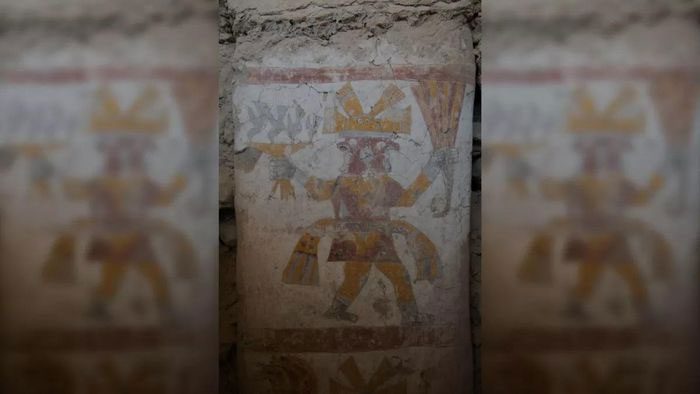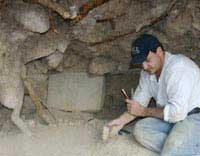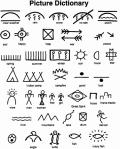Archaeologists have uncovered two 1,400-year-old Moche murals adorned with red and brown hues, depicting a man with two faces. This individual is illustrated wearing a round hat, a mask, and luxurious clothing.
The two murals feature the two-faced men holding unusual treasures, such as a cup from which a hummingbird is drinking—details that may allude to sacrifice and the “cosmos.” These murals were recently discovered at the 1,400-year-old archaeological site of Panãmarca along the coast of Peru.
Both murals, which decorate a column in a ceremonial hall, are highly detailed. In one mural, located near the top of the column, there is an image of a man with two faces—one looking to the left and the other to the right—holding a feathered fan in one hand and a cup featuring four hummingbirds drinking in the other. The second two-faced man, depicted lower on the column, holds a moving feathered fan in one hand and what appears to be a staff in the other. Researchers suggest that the artisans may have experimented with ways to depict movement.

One of the two-faced men is displayed here. The cup held on the left features four hummingbirds drinking water, and a feathered fan is held in the other hand.
Both men wear what appears to be a hat or crown on their heads and are dressed in colorful attire adorned with intricate patterns and seemingly large belts. These murals were excavated by archaeologists in August 2022.
Experimenting with Movement Imagery
Why the Moche depicted these two men in such a manner remains a mystery. Lisa Trever, an associate professor of art history and pre-Columbian archaeology at Columbia University and one of the leads on the project, remarked: “There is nothing like this in South American archaeology. The artisans may have experimented with ways to convey movement and tell two stories at once.”
These murals were painted between 550-800 CE, during a time when Moche civilization thrived along the coastal regions of Peru. The Moche civilization constructed large temples, engaged in human sacrifices, and created exquisite artworks, such as ceramic cups intricately carved in the shape of human heads. They existed in a period before a writing system was utilized in Peru.
The two men depicted in this mural may represent deities, though this is uncertain. “Typically, images of deities in Moche art have non-human features such as fangs, faces, tails, or wings of various creatures. This image, aside from the two faces, appears entirely human,” Trever noted.
The Mysterious Hall
Panãmarca is an architectural complex located in the lower Nepenã Valley of Peru. The hall featuring the murals of the two-faced men also contains other murals depicting a priestess, a snake, and a bat. Archaeologists have studied them for over 60 years, having discovered the first mural in 1958. Despite decades of research, much of the hall remains unexcavated, and many other murals may still await discovery.
It remains unclear how the Moche civilization utilized this hall. Trever stated: “One of the very interesting and challenging aspects of this complex is the unusual density of murals inside. This means we still have many questions about its architecture and function.”
It is uncertain how many people had access to this hall. Trever elaborated on a significant finding: “This was certainly a space not intended for the public, given the narrow pathways and confined interior. It must have been a very special place, perhaps reserved for leaders or elders of the Panãmarca community.”
Edward Swenson, director of the Archaeological Center at the University of Toronto, Canada, who is not involved in the research project, stated that these new discoveries are significant.
Having extensively researched the Moche civilization, Swenson expressed: “The Panãmarca murals are truly spectacular, and the discoveries of 2022 will undoubtedly significantly aid archaeological and art historical efforts to reconstruct the cosmological meanings and religious narratives of the Moche civilization.”





















































